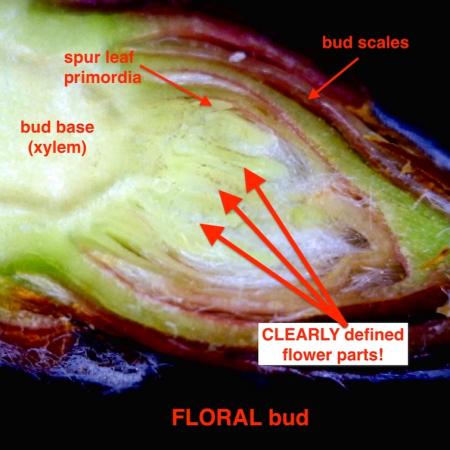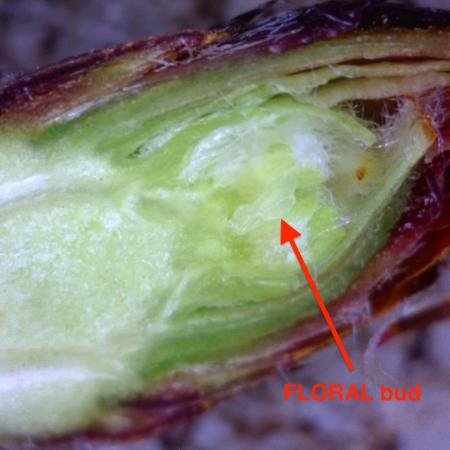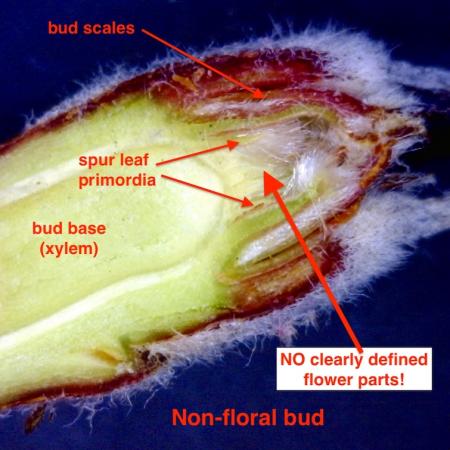HRT-Precision crop load management of Honeycrisp: flower bud identification and precision pruning
Precision crop load management of Honeycrisp: flower bud identification and precision pruning
Jon Clements, UMass Amherst, jmcext@umass.edu
Win Cowgill, Professor Emeritus Rutgers, Win Enterprises Int., LLC, wincowgill@mac.com
Why precision-prune Honeycrisp?
- Honeycrisp is very prone to biennial bearing. You can’t afford to have “on” and/or “off” years
- Over- or under-cropping Honeycrisp results in biennial bearing and has adverse effect(s) on fruit quality
- Precision crop load management of Honeycrisp, particularly in tall-spindle orchards is recommended, which includes precision pruning, precision thinning, and return bloom sprays
- Understanding what percent of spurs are flowering is an important step in precision pruning, however, with Honeycrisp buds must be dissected and magnified to determine this percent, you cannot simply tell by observation (unlike some other varieties, and note that they can be precision-pruned too)
What is precision pruning?
- Precision pruning is determining a desirable crop load (number of apples per tree), determining what percent of spurs (buds) are flowering (or not), and then pruning until a desired bud count is reached
- Note that determining the desired crop load is FIRST determined by the target yield per acre (1,000 bushels for example) then dividing by the number of trees per acre to get apples per tree; alternately you can simply decide how many apples per tree you want based on tree density, age, training system, and/or fruiting spur branch density
Flower buds vs. non-flower buds – why and how?
- Have to be able to identify spur buds as floral or vegetative, remembering, buds are initiated the growing season (in May/June) before dormant pruning
- Factors that affect whether a flower bud is formed (or not formed) the previous season?
- Honeycrisp induces and then initiates flower buds early, beginning just after bloom and finishing as early as 30-45 days after boom; therefore, fruit thinning must be accomplished early (with blossom and petal fall NAA sprays)
- Honeycrisp thinned to no more than one fruit per spur will result in more flower bud formation
- Thinning/return bloom sprays beginning at bloom and petal fall (NAA) and then again (if needed) using NAA in the traditional thinning stage of 8 to 12 mm. fruit size promote flower bud development
- Keep spurs exposed to sunlight, trees should not be stressed, have excellent nutrition and adequate irrigation, etc.
Flower buds vs. non-flower buds – identification
- Just before pruning is started, collect a random sample of what appear to be flowering spurs from each block – a sample of 30 to 50 buds is recommended
- Make a longitudinal slice right in the center of each bud with single edge razor blade to expose bud insides (make as clean a cut as possible)
- Magnify with the instrument of your choice -- a binocular-scope or digital microscope -- to identify if flower bud or not, flower parts should be obvious (see pictures)
- Determine, % buds with flower parts vs. no flower parts, for example if a sample of 30 buds is taken, and 18 are seen to have flower parts (12 do not) then it is presumed you would have 60% flowering spurs across the block
- Consider some other factors: large crop last year equals more likely to have non-floral buds (blanks); bud size, all things being equal, larger buds are more likely floral vs. smaller buds more likely non-floral (but with Honeycrisp it’s hard to tell for sure unless you dissect and examine under magnification); cropping history, rootstock, absence of spur buds, etc. Use your experience in addition to procedure described above, but dissection and magnification is the only way to know for sure what percent of buds are floral on Honeycrisp (and perhaps other hard-to-tell apple varieties).
Precision-prune and follow-up
- Determine how many buds (floral and non-floral/blanks) to leave after precision pruning based on the desired final crop load. For example, if tree starts out with 200 apparent flower buds, and desired crop load is 60 apples, 1.5 times 60 = 90 buds, but if only 60% are floral, then need to leave 150 buds after pruning (remove 50 buds)
- Prune to desired bud count, use thinning cuts, spur bud extinction (particularly those vertical oriented, up or down)
- Adjust bud load by pruning at pink if possible (most growers that is not)
- Apply a bloom thinning spray using NAA
- Apply a petal fall thinning spray using NAA, and then again at 8 to 12 mm. (if necessary) using NAA (and carbaryl if indicated) using the carbohydrate model (to time and adjust rate) and the fruit growth rate model (Malusim app, malusim.org)
- Hand thin if necessary within 35 days of full bloom
- Apply return bloom sprays -- NAA at 25 mm. and/or ethephon at 30 to 35 mm (only if less than 80 degrees F. for ethephon) – every seven days, remembering flower bud formation is nearly complete 45 days after bloom. Make sure to cease ethephon sprays 45 days before harvest as to not trigger early ripening. Some research has shown that Ethephon applied immediately after harvest (at two pints per acre) will help promote fruit bud formation the following season.
Acknowledgment: Special thanks to Dr. Poliana Francescatto, Valent Biosciences for assistance in ID of floral vs. non-floral buds, and her work while a post-doc at Cornell in identifying early flower bud formation of Honeycrisp apples



